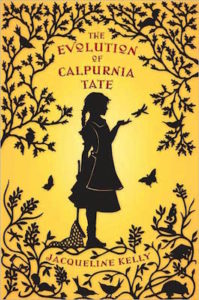One day I would have all the books in the world, shelves and shelves of them. I would live my life in a tower of books. I would read all day long and eat peaches. And if any young knights in armor dared to come calling on their white chargers and plead with me to let down my hair, I would pelt them with peach pits until they went home.
Thus declares eleven and three quarters year old Calpurnia Tate in defense of the life of independent learning and discovery she intends to lead upon achieving the age of majority. Sadly, and as she comes to learn, in the Texas countryside of 1899, just because a girl grows up to be a woman does not mean she will necessarily be able to control her own destiny. However to fix one’s attention on this single thread of the exquisite narrative braid that Jacqueline Kelly’s novel The Evolution of Calpurnia Tate weaves for the reader would be akin to missing the splendor of a field of wildflowers for the sake of a single bud.
Born into a solidly middle-class farming family in post Civil War Texas, where although the land has since healed the people who inhabit it still bear tender and very visible scars, Calpurnia “Callie Vee” Tate finds herself in the summer of 1899 standing not only at the edge of adolescence but upon the edge of a new century as well – a century that will be dominated not by horses and wagons but by combustion engines and telephones. Distances will shorten, time will be compressed, and vast possibilities will open up for many who never dared dream of them before. Yet as seen through the eyes of a young girl in Fentress, Texas, the world is very much as it likely has always been and shall likely always be.
That is unless said young girl one day notices that there seem to be two different types of grasshoppers to be found in the fields near her family’s pecan orchard surrounded home. Even more importantly that merely noticing this curious fact, she asks the crucial question upon which all scientific investigation, all experimentation, all human activity that seeks to shine the light of knowledge and understanding through the darkness of ignorance and fear rests: “Why?”
Asking this one simple and seemingly innocent question and setting out to discover its answer leads her to a host of other wholly unexpected discoveries, from the writings of Charles Darwin and the fears his work brought to the surface in many who preferred their world unexamined and unexplained, to her mysterious and solitary grandfather, the history of her own family, and the often unpleasant realities existing just beneath the surface of her seemingly well-ordered world. Yet perhaps even more important than her discoveries are her questions (recorded as a recurring stream of asides that make the novel’s first person narrative so marvelously authentic) not only about the world around her but about herself and her place in it.
In the hands of a writer of less skill and a smaller imagination, Calpurnia’s story might easily be spun out in a series of treacle-sweet and over-wrought vignettes populated by cliché characters (the novel is intended for “young adult” readers after all). Fortunately Callie Vee sprung from the mind of Jacqueline Kelly, a writer of sublime skill and superb creativity who through the application of her talent enables the story to transcend the boundaries of conventional “young adult” fiction and attain that seldom-achieved level of story-telling that defies categorization. Because of this, Calpurnia’s adventures, her discoveries, and even her failures are recounted with a straight-forward honesty of spirit that brings the beauty and wonder of a budding naturalist’s mind to the reader with such clarity that personal association, especially for those of a naturalist mind themselves, is unavoidable.
Calpurnia Tate is the child all naturalists wish they were as children: endlessly curious, possessing of boundless energy, and most important of all, beginning their explorations of the natural world at an age when the mind has not yet been conditioned to repress questions because they might seem silly or pointless to others. It is devotedly hoped that The Evolution of Calpurnia Tate will be read by young and old alike, to inspire, remind, or rekindle, as the case may be, in the reader the spirit of open and honest inquiry about the world around them and the myriad forms of life inhabiting it – including the people living right alongside them in their own homes.
In 2010, The Evolution of Calpurnia Tate was selected as a Newberry Honor Book by the by the American Library Association.
 Title: The Evolution of Calpurnia Tate
Title: The Evolution of Calpurnia Tate
Author: Jacqueline Kely
Publisher: Henry Holt and Co.
Date of Publication: May 2009
ISBN: 978-0-8050-8841-0
In accordance with Federal Trade Commission 16 CFR Part 255, it is disclosed that the copy of the book read in order to produce this review was purchased by the reviewer.
If you enjoyed reading this, please consider signing up for The Well-read Naturalist's newsletter. You'll receive a helpful list of recently published reviews, short essays, and notes about books in your e-mail inbox once each fortnight.
